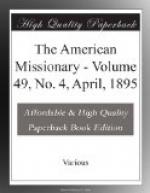A little incident in Tougaloo interested me. A discussion of the topic, “How can we improve our homes,” called from one student these words: “I find the negro lacks race pride. He despises his own makeup. Who of you ever heard any negro say that he thought the general characteristics of his race were as becoming as those of other races? Nor are they. The Anglo-Saxon is proud of his race characteristics. The Indian is, also, but the negro despises himself and would be anything else than what God has made him. But how can we escape hell if we hate ourselves because we are negroes, when this is the divine wisdom of a just God? We may talk about improving our homes by getting an education as much as we please, but we will never be anything until we have a race pride and try to carry out the great plan of God who made us and knew what is best for us. Let us be genuine negroes, pure and good, and not desire a drop of other blood in our veins.”
This seems to be the spirit of Tougaloo. Its graduates whom I have met are manly and womanly, self-respecting and self-helping.
TOUGALOO UNIVERSITY, MISSISSIPPI.
BY PRES. F. G. WOODWORTH, D.D.
[Illustration: MANSION.]
[Illustration: GIRLS’ DORMITORY.]
The chartered schools of the American Missionary Association, though doing an essentially similar work, are yet strongly individualized. Tougaloo University is emphatically the black belt plantation school of the Association, located in the country, in the midst of America’s darkest Africa, touching that by far most numerous and important class on which the future of the negroes mainly rests—the plantation negroes. Forming the bulk of the colored population, least tinged with white blood, they are at once the most ignorant and the most hopeful class. Within seven miles of Jackson, the State capital, on the Illinois Central road, easily accessible, not only from Mississippi, but from large regions of Louisiana and Arkansas, it draws pupils from a wide area and sends its trained teachers and graduates to a region still wider. Its location is healthful and one of beauty, and, removed from town distractions and temptations, it is admirably situated for efficient work. The school was established in the autumn of 1869, and the early reports show a surrounding region which in its drunkenness, fighting and iniquity, is quite in contrast with the present condition of affairs. Five hundred acres of land were purchased and with them a fine mansion (page 125), then not many years old, intended for the finest plantation house of the State and built for a bride who came not. As the illustration shows, it is a handsome structure—the only one with any decided architectural pretensions in the place. It served at first for school rooms and dormitory purposes, and has been thus used during most of the life of the school. Now it contains the offices of president




